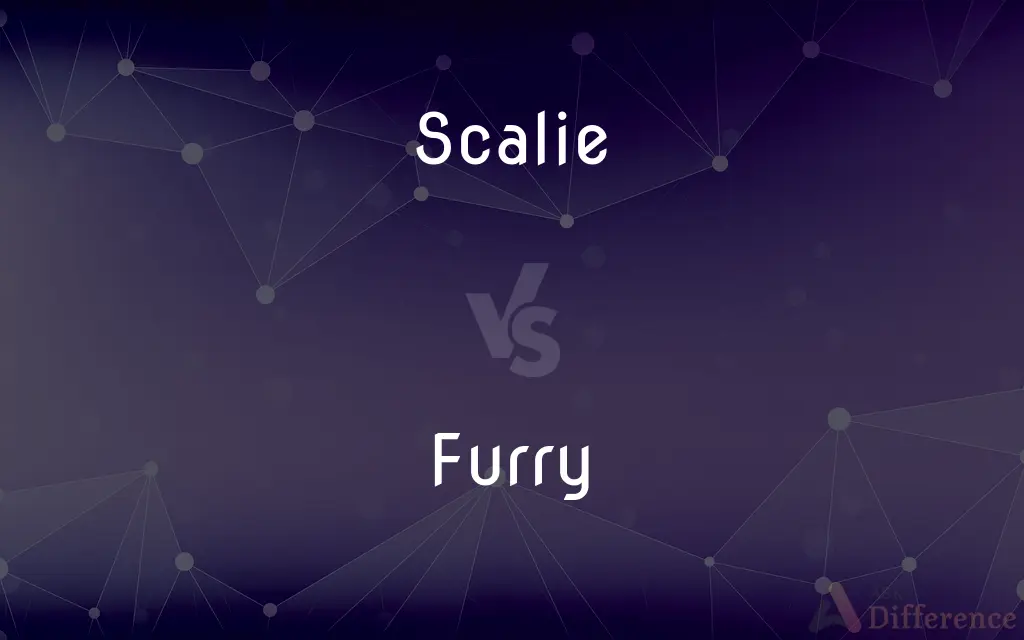Scalie vs. Furry — What's the Difference?
Edited by Tayyaba Rehman — By Fiza Rafique — Updated on April 23, 2024
Scalies are enthusiasts who focus on anthropomorphic reptilian characters, often featuring scales while furries are fans of anthropomorphic animal characters typically with fur, such as mammals.

Difference Between Scalie and Furry
Table of Contents
ADVERTISEMENT
Key Differences
Scalies, a subset within the broader furry community, specifically gravitate towards reptilian and other cold-blooded creatures like dragons, lizards, and snakes. These characters are often depicted with scales and may embody characteristics associated with reptiles. In contrast, furries engage with a wider range of anthropomorphic animal characters, primarily focusing on mammals such as wolves, foxes, and cats, which are generally depicted with fur.
While both communities enjoy creating and embodying characters through costumes, art, and role-playing, scalies often emphasize the unique textures and features of reptilian forms, such as scales, tails, and sometimes wings. Furries, on the other hand, might focus more on fur texture, color patterns, and mammalian traits like ears and tails.
The types of activities at community gatherings, like conventions, can be similar for scalies and furries, involving costume parades, art displays, and social events. However, the thematic content often differs, with scalies perhaps engaging more with mythological and fantastical themes due to the common inclusion of dragons and mythical serpents, whereas furry activities might not specifically lean towards fantasy.
Cultural representations also differ; scalie characters might appear more often in contexts that call for mythical or alien-like creatures, aligning with the fantastical or ancient mythological aesthetics. Conversely, furry characters are frequently seen in a variety of settings, ranging from domestic to wild, and are often used in narratives exploring human-like emotions and societal themes.
The appeal of these communities also varies; scalies might be drawn to the aesthetic and symbolic qualities of reptiles and similar creatures, finding beauty in the exotic and less conventional. Furries might connect more with the warmth and familiarity of mammalian characters, often relating to their expressive faces and the human-like warmth attributed to fur.
ADVERTISEMENT
Comparison Chart
Focus Creatures
Reptilian and other cold-blooded animals
Mostly mammalian with fur
Character Traits
Scales, tails, often more mythical
Fur, mammalian features like ears and tails
Common Themes
Mythological, fantastical
Diverse, often including everyday scenarios
Cultural Context
Often aligned with fantasy, mythology
Broad, including domestic and wild contexts
Appeal
Exotic, unusual aesthetics
Warmth, familiarity, human-like emotions
Compare with Definitions
Scalie
Scalies that are snake-like, often with elongated bodies and scales.
Serpent characters often feature in her stories.
Furry
The practice of wearing costumes depicting furry characters.
Fursuiting is a major activity at furry conventions.
Scalie
Enthusiasts who appreciate anthropomorphic reptilian characters.
He dressed as his favorite scalie character for the convention.
Furry
Engaging in character-driven scenarios within the furry community.
Furry role-play often includes complex backstories and interactions.
Scalie
Scalie characters based on lizard-like traits and appearances.
He role-plays as a lizardfolk in online forums.
Furry
Artwork focusing on the design and aesthetics of furry characters.
His gallery features extensive furry art.
Scalie
A popular type of scalie character, often depicted with wings and fire-breathing abilities.
Her dragonkin artwork is famous in the scalie community.
Furry
Fans of anthropomorphic furry animals who often create and wear costumes.
She has been a part of the furry community for over a decade.
Scalie
Scalie characters that blend real reptilian features with mythical elements.
The mythical scalies in his novel draw powers from ancient lore.
Furry
A common type of furry character, noted for their clever traits.
Anthropomorphic foxes are a favorite in furry art.
Scalie
(furry fandom) A reptile or reptile-like animal character with human characteristics.
Furry
Consisting of or similar to fur.
Scalie
A strikebreaker.
Furry
Covered with, wearing, or trimmed with fur.
Scalie
A weighbridge worker.
Furry
Covered with a furlike substance.
Scalie
A scaled quail (Callipepla squamata).
Furry
Having a furlike quality, as in tone; fuzzy
A furry voice.
Scalie
(furry fandom) Someone who roleplays or describes themselves as being such a character. compare furry
Furry
Covered with fur, or with something resembling fur.
His treatment of our furry friends was nothing short of appalling.
Furry
(informal) Of or related to the furry subculture.
Furry
An animal character with human-like characteristics; most commonly refers to such characters created by members of the furry subculture.
What percentage of furries are wolves?
Furry
A member of the furry fandom.
The furry had designed an elaborate costume.
Furry
Someone who roleplays or identifies with a furry character. (Compare therianthrope.)
Furry
Covered with fur; dressed in fur.
Furry
Consisting of fur; as, furry spoils.
Furry
Resembling fur.
Furry
Covered with a dense coat of fine silky hairs;
Furred animals
A furry teddy bear
Common Curiosities
Can someone be both a scalie and a furry?
Yes, someone can identify with both communities, enjoying the diverse aspects of different anthropomorphic animals.
How do furries create their characters?
Furries often create characters by mixing various animal traits, personal characteristics, and creative elements into a unique anthropomorphic identity.
How inclusive are scalie and furry communities?
Both communities are known for their inclusivity and welcoming nature, embracing people from various backgrounds with shared interests.
How do scalie and furry preferences differ in media?
Scalies might prefer content with dragons and mythical beasts, while furries might enjoy media portraying anthropomorphic mammalian characters in various narratives.
What drives someone to identify as a scalie?
Many scalies are drawn to the unique aesthetics and traits of reptilian creatures, finding them exotic and fascinating.
How do people react to public displays of scalie or furry identities?
Public reactions can vary widely, from curiosity and interest to misunderstanding and prejudice.
Are scalie and furry identities more common in any age group?
While popular among young adults, these identities can be found across a broad age range, appealing to diverse groups.
What challenges do scalies face within the broader furry community?
Scalies may face challenges in gaining the same recognition or finding as extensive content and merchandise tailored to reptilian characters.
Are there specific events for scalies?
While there are general furry conventions, some events or meet-ups specifically cater to scalie enthusiasts.
How do these identities influence personal relationships?
Participating in these communities can enhance personal relationships by providing a shared interest and supportive environment.
What are common misconceptions about scalies?
A common misconception is that scalies only like scary or villainous characters, whereas many are drawn to the diverse and rich mythologies of reptilian creatures.
What is the role of online platforms in these communities?
Online platforms are crucial for connecting scalies and furries worldwide, allowing for the sharing of art, ideas, and organizing events.
What kind of materials are used in scalie costumes?
Scalie costumes often use materials that mimic scales, such as sequined fabrics or molded plastics, to achieve a realistic look.
How do furries and scalies contribute to their communities?
Both groups contribute through art, storytelling, and community-building activities, often raising funds for charities or fostering supportive networks.
How can someone new get involved in either community?
Newcomers can start by participating in online forums, attending conventions, and engaging with community art and activities.
Share Your Discovery

Previous Comparison
Poplar vs. Alamo
Next Comparison
Cornichon vs. PickleAuthor Spotlight
Written by
Fiza RafiqueFiza Rafique is a skilled content writer at AskDifference.com, where she meticulously refines and enhances written pieces. Drawing from her vast editorial expertise, Fiza ensures clarity, accuracy, and precision in every article. Passionate about language, she continually seeks to elevate the quality of content for readers worldwide.
Edited by
Tayyaba RehmanTayyaba Rehman is a distinguished writer, currently serving as a primary contributor to askdifference.com. As a researcher in semantics and etymology, Tayyaba's passion for the complexity of languages and their distinctions has found a perfect home on the platform. Tayyaba delves into the intricacies of language, distinguishing between commonly confused words and phrases, thereby providing clarity for readers worldwide.
















































